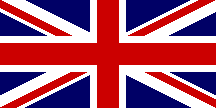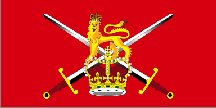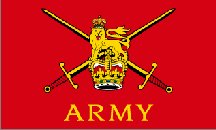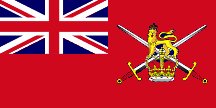|
Why the British Army doesn't have a typical British Royal Ensign
In the 17th century occurred what is known here as "The Great Civil War," between the King and Parliament. Parliament won and, in 1649, King Charles I was executed. Eleven years later, the monarchy was restored, in the person of his son, King Charles II. Although Charles II had agreed to accept the powers of Parliament in the Declaration of Breda, there were many who were suspicious. They thought that he might say one thing and then, after being restored to the throne, return to his father's policies. The navy supported Charles, but large parts of the army did not. This was perhaps not surprising, as the army of the time was very much the creation of Parliament and, in particular, of Oliver Cromwell. When Charles was restored to the throne, he proclaimed that, because of its support for him, the navy would henceforth be called the "Royal Navy." Regarding the army, he said nothing.
|
|
|
Royal Navy and Marines 1707 |
|
Royal Air Force 1918 |
This is why to this day, it is the "Royal Navy," but only the "British Army." The Royal Air Force, which came into being in 1918, had the royal title bestowed by King George V. During Colonial times, the British Army was allowed to use Queen Anne's Red Ensign, however, they were still not considered a "Royal" service.
|
|
 |
| Colonial Red Ensign |
|
The Union Flag |
In this connection, you should remember that the Union Flag is also technically a royal flag, symbolizing the dominions under the rule of the monarch, and has never been adopted as the national flag of the United Kingdom, although it now serves that purpose on land. So here again, as the British Army is not the "Royal Army," it does not use the royal flag, and continues to use its own "Non-Ceremonial" flag.

British Army Non-Ceremonial Flag 1938
That individual units of the British army, such as the Royal Artillery (Royal Logistics Corps), very definitely a part of the British Army, have been designated "Royal" and thus have proper "Royal" ensigns, but that the army as a whole still does not, is now simply a tradition. However, as you probably know, the British are very serious about traditions, even the weirder ones!
|
|
|
Royal Army Ordnance Corps Ensign 1918 |
|
Royal Army Ordnance Corps Ensign 1940 |
Note: The "Army Service Corps" (ASC) became the "Royal Army Ordnance Corps" (RAOC) in 1918, and then amalgamated with the Royal Corps of Transport (RCT), the Royal Pioneer Corps (RPC), the Army Catering Corps (ACC), and the Royal Engineers Postal and Courier Service (PCS) to become the "Royal Logistic Corps" (RLC) in 1993.
To further confuse things, individual regiments of the British Army have always borne two colours. Their Royal Colours was in the form of the Union Flag, their Regimental Colours in the colors of the facings of the regiment. In the Brigade of Guards, this is reversed, the Union Flag being the Regimental Colours. For other examples, the Royal Army Service Corps, a part of the Army, has the royal title, as do the Royal Engineers, the Royal Military Police, the Royal Electrical and Mechanical Engineers and many other regiments, so even if the army has been forgiven for its hesitation over accepting Charles II, the tradition of the Army not being "Royal" as a whole remains.

British Army Ensign 1999
The Army Flag was altered in 1999 to add the word "ARMY." This change was opposed by Graham Bartram. He is Chief Vexillologist of the British Flag Institute and a consultant to the Government on flags. The alteration went ahead, but the older flag (without the inscription) is still being commonly used. Also, a strong subject of debate is removing the word "ARMY." Critics of the newer design argue that looking at it sensibly, if you have an emblem of crossed swords under the Royal Crest, could it really be anything but the army?

Proposed British Army Ensign
Actually, according to Graham Bartram, the Army has been offered the ensign shown above to replace the Non-Ceremonial flag so that they will be on equal footings with the other two services. The flag is royal crimson (the dark red used in the Royal Standard) with the Union flag in the canton and the Army badge of the Royal Crest on Crossed Swords filling the fly. He says the proposal is currently stalled, but still under consideration.
|